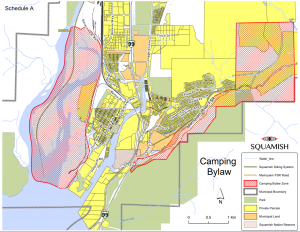Camping Bylaw
District of Squamish Council adopted a Camping Regulation Bylaw on July 23, 2019.
Background
Squamish welcomes recreation-driven tourism as it is part of our Hardwired for Adventure brand identity, and is a significant economic and tourism driver for the community.
The popularity of Squamish within the #vanlife or “freedom” camping community has increased to the point where there is great concern about the group’s collective environmental impact.
Crown land camping in Squamish has become more concentrated as the volume of campers increases every year. The impacts of camping on crown land have correspondingly increased resulting in an increase in wildlife and neighbourhood interface issues, wildfire risk and waste management impacts including the improper disposal of human waste and garbage.
Squamish has several privately-owned campgrounds as well as provincial- and municipal-operated campgrounds. Many have available sites on a given night, while campers are camping in undesignated areas. Most of these campgrounds are also equipped to handle overflow capacity during busy summer weekends. These campgrounds have facilities to mitigate risks, such as fire pits and education during fire bans, wildlife-proof food caches, secure garbage facilities and staff on hand to provide people who are new to camping with education on how to enjoy our recreation assets without unintended negative impacts on the community or environment.
Bylaw Objectives
This bylaw is intended to enable seasonal recreation-driven camping in a way that mitigates the social and environmental impacts as a result of an increased volume of crown land camping in Squamish. The bylaw aims to preserve the joy of camping without the impact to the environment, by restricting camping within identified sensitive areas within the municipal boundary to designated campsites. In particular, this Bylaw provides the District of Squamish with a tool to enforce ‘no camping’ restrictions in Camping Bylaw Zones - sensitive areas along the Mamquam Forest Service Road/Powerhouse Springs Road, the Squamish Estuary and the Spit.
Dispersed camping is allowed on crown land outside the boundaries of the municipality, per the provincial Land Act, for up to 14 consecutive calendar days.
Responsible Camping
To assist campers with finding available campsites in Squamish, Tourism Squamish has created an online tool to identify campsite availability each night. The tool provides campers with a calendar identifying available campsites at local campgrounds. View the Available Campsites tool.
No Trace Camping Best Practices
- Check for fire danger rating and for local fire bans that restrict the use of campfires.
- Secure all food to avoid attracting bears and other wildlife.
- Never keep or consume food in your tent.
- Always secure and ensure proper disposal of garbage, organics and recycling.
- Ensure proper disposal of human waste and toilet paper.
- Before leaving, return your site to the condition in which you found it.
Van-Dwelling Community
The bylaw aims to balance the perspectives and values shared among Squamish's van dwelling community of full-time Squamish residents who live and work in the community year-round. The District has worked with representatives of this community to understand any unintended impacts the bylaw might have and have worked to address some of their concerns, while balancing the needs of other residents. Dialogue with the entire community will remain ongoing.
Enforcement
Municipal bylaw officers, in conjunction with local police and provincial agencies, will focus enforcement efforts on seasonal campers through routine patrols in the Estuary and Spit, as well as portions of the Mamquam Forest Service Road, Powerhouse Springs Road and adjacent parcels of crown land.
Anyone camping within the identified sensitive areas will be asked to relocate. Campers that are unwilling to voluntarily move to an authorized camping area will be subject to a fine of $100. The Traffic Bylaw already prohibits camping on municipal roadways.
Resources
Campsite Availability Calendar
Map: Camping Bylaw Zone, Schedule A
District of Squamish Camping Bylaw No. 2679, 2019
District of Squamish Bylaw Notice Enforcement Bylaw No. 2418, 2015
District of Squamish Municipal Ticket Information Bylaw No. 1832, 2004

